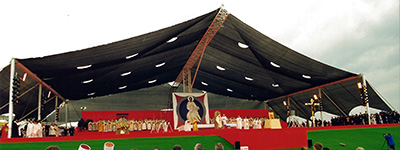 But the contemplation of the beauty of the face of Christ awakens in man his true nature: Christians through baptism become new men, manifesting to the world true love, that is love to the enemy, love to the point of giving up one’s life for the other.
But the contemplation of the beauty of the face of Christ awakens in man his true nature: Christians through baptism become new men, manifesting to the world true love, that is love to the enemy, love to the point of giving up one’s life for the other.
«We know that we have passed from death to life because we love the brothers.» [8]
For this reason there is a tight bond between beauty and evangelization: the beauty of the face of Christ is translated into the beauty of the Christian community, the living body of Christ in history. It is the community, which reveals the beauty of God’s nature in communion and forgiveness. Jesus says:
«He who sees me has seen the Father» [9]
So he who sees the Christian community, where the love to the enemy appears, sees the true icon of Christ.
In the course of history, the Church has always perceived this bond between beauty and evangelization. The Church along the centuries has been the greatest producer of beauty. Everything reflects the beauty of Christ and the beauty of the community and of fraternal communion. The evangelization of Slavic peoples was made especially through the beauty of the liturgy, of the icons and of the songs.
Only in these last years, even within the Church, there seems to prevail a functional vision. This vision reduces the places where the community lives, meets and gathers, to simple meeting-rooms.
Today, more than ever, it is necessary and urgent that the structures of the Church may be renewed. The answer to the global village, to the Great City, to the mono-culture, is a parish that may become a “heavenly village”. A social model that is more human and capable of opening spaces for the new civilization of love, a Eucharistic assembly that may favor the active participation of the faithful, a reality of community with a catechumenium composed of beautiful liturgical rooms for celebrations in small communities.


The project of Domus Galilaeae and the tent where the Pope celebrated the Eucharist on March 24th on the Mount of Beatitudes, are an attempt to rediscover architectural and iconographic shapes that may help to reintroduce beauty into the life of the Church.
References
[1] John 1,3; The New Jerusalem Bible, Doubleday press.
[2] Psalm 45,2; The New Jerusalem Bible, Doubleday press.
[3] Giacomo Leopardi, Hymn to his Woman.
[4] Genesis 2,23; The New Jerusalem Bible, Doubleday press.
[5] Exodus 19,10-14; The New Jerusalem Bible, Doubleday press.
[6] Song of Songs 4,1; The New Jerusalem Bible, Doubleday press.
[7] Luke 7,22-23; The New Jerusalem Bible, Doubleday press.
[8] First Letter of John 3,14; The New Jerusalem Bible, Doubleday press.
[9] John 1,3; The New Jerusalem Bible, Doubleday press.
